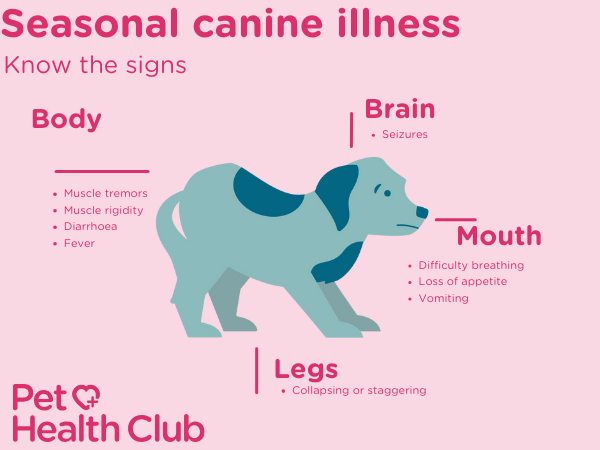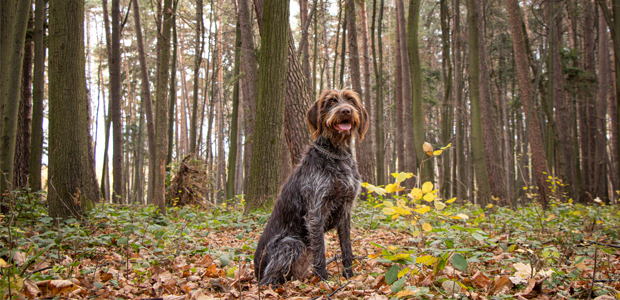Seasonal canine illness (SCI in dogs)
First Published: 20/12/2021
Last Updated: 30/10/2023
Seasonal canine illness (SCI) is a rare but serious condition that affects dogs in late summer and early autumn. It can affect any dog, no matter the breed, size, or age.
While we don't know exactly what causes it, there might be a link to harvest mites. Getting to a vet early can really help.
Brief summary
- Seasonal canine illness commonly occurs in late summer, early autumn
- While the exact cause is unknown, there is a possible link to harvest mites
- Symptoms include vomiting, diarrhoea, and muscle tremors
- Early vet intervention improves prognosis
- Awareness and early treatment have reduced fatalities
What causes SCI in dogs?
The exact cause of SCI remains a mystery, unfortunately, despite lots of research. Initial theories suggested the illness might be linked to mushroom poisoning or algae, but these have been largely discounted. The most enduring theory revolves around a potential link with harvest mites, as many dogs with SCI were noted to have these tiny mites on them. All cases appear to have developed soon after a woodland walk, and occur between August and November, peaking in September.
Harvest mites on dogs connection
Many dogs diagnosed with SCI are discovered to have harvest mites. These tiny, orange creatures thrive in long grass and dense foliage, particularly during late summer and autumn. Similar to ticks on dogs, they latch onto passing mammals, including dogs, feeding on their blood for two to three days before dropping back off. You'll often find them in front of the ears, at the base of the ear flap, or between the toes. They also show up on the belly, at the tops of the legs, on the chin, or even the lips. You can actually see them as tiny orange spots if you look closely.
These mites can make your dog quite itchy and uncomfortable. Some dogs are very sensitive to the mite saliva and develop sore, itchy and red patches of skin when affected.
Unresolved mysteries
One theory about SCI in dogs is that some harvest mites carry a virus, while another suggests they feed on a specific substance in woodlands that triggers the illness in dogs. However, these are both unproven as yet. The cause of SCI is likely linked to something specific in woodland areas, but researchers and vets haven't been able to pinpoint what this is. Until more research is conducted and the mystery unravelled, the exact cause of SCI will continue to be a puzzle, making prevention and early detection the main defence.
Seasonal canine illness symptoms
- Vomiting in dogs
- Diarrhoea (potentially with blood)
- Tiredness
- Stomach pain
- Muscle tremors
- High temperature
These signs can escalate rapidly, sometimes becoming severe within a few hours, and dogs can become rapidly dehydrated and weak. In the worst cases, blood may be present in the vomit and diarrhoea, which can be alarming to see.
If your dog shows any of these symptoms, especially within 72 hours of visiting a woodland area, contact your vet immediately. Quick treatment can make a significant difference.

How do vets diagnose seasonal canine illness?
Diagnosis of SCI in dogs can be tricky due to the absence of a definitive test. The diagnosis largely relies on symptoms, a physical examination from a vet, and your dog's recent activities - especially woodland walks. Vets may conduct general tests such as blood tests or x-rays to rule out other conditions with similar symptoms, before narrowing down to a SCI diagnosis. Your input is really important in this process. Providing detailed information about where you've been with your dog and the symptoms you've observed can help your vet make an educated assessment and start with the most appropriate treatment.
Is there a cure for seasonal canine illness?
While there isn't a specific cure due to the unknown cause, prompt treatment aimed at alleviating the symptoms can be highly effective. Treatment may include:
- Intravenous fluids to combat dehydration
- Anti-nausea medication to control vomiting
- Pain relief for abdominal discomfort
- Antibiotics to prevent secondary bacterial infections
- Using a topical spray to kill and remove any harvest mites
How to reduce the risk of SCI in dogs
While there's no surefire way to prevent SCI in dogs, certain steps can minimise the risk:
Avoid long walks in woodland areas during autumn, especially around September
Keep your dog on a lead to control their exposure to potentially risky areas
Apply parasiticide sprays (prescribed by your vet) to the feet, legs and underside of your dog about 1-2 hours before woodland walks to deter harvest mites
If you notice any harvest mites on your dog, wipe them off with a damp cloth as soon as possible, and talk to your vet about a topical treatment spray.
Research and awareness around SCI have improved over the years. There has been a drop in fatal cases since 2010, showcasing the impact of early intervention and the veterinary community's growing understanding of the illness.

Are there any SCI hotspots in the UK?
SCI first emerged among dogs who had been walking in the Sandringham estate in Norfolk. More cases then began to surface in other woodland areas, particularly in East Anglia, Nottinghamshire, and Lincolnshire. Commonly reported hotspots in the UK have included (although these locations can vary over time):
- Sherwood Forest in Nottinghamshire
- Thetford Forest on the border between Norfolk and Suffolk
- The New Forest in Hampshire
- Cannock Chase in Staffordshire
- Clumber Park in Nottinghamshire
- Sandringham Estate in Norfolk
It's important to note that while these areas have had reports of SCI, this illness is still rare. If you plan to walk your dog in these or other woodland areas, just be vigilant and watch for any symptoms. Check with your local vet practice or animal health organisation for the most current information.
Any studies around SCI in dogs?
One study published in 2012 highlighted incidents between 2009 to 2011 where dogs became seriously ill or died after woodland walks, especially in Norfolk and Nottinghamshire, due to SCI. In one case, two Yorkshire terriers from Bolton experienced severe harvest mite infestations after a long walk in Delamere Forest, Cheshire, followed by one of the dogs succumbing to SCI. The study suggests that the severe infestations and exposure to mite saliva could potentially trigger SCI.
The now defunct Animal Health Trust documented over 300 cases of SCI, including 16 fatalities. It also said many more instances may have gone unreported.
Another study published in 2013 explored a potential link between mushroom poisoning and SCI. The report noted similar symptoms between the two conditions — such as vomiting, diarrhoea, and lethargy — especially after dogs had visited woodland areas in autumn. The study raised the possibility that some cases thought to be SCI might actually be mushroom poisoning. But it concluded there's no clear evidence yet linking mushroom toxicosis to the cluster of SCI cases.
Need more advice?
If you’re worried about SCI in your dog speak to your vet as early as possible. You can find your nearest vet using our find a vet page, or speak to a vet online using our online vets service.



